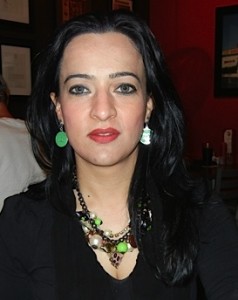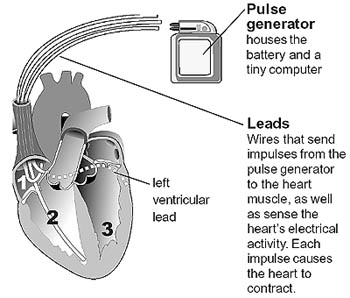How Bi-Ventricular Pacemakers are Saving Lives
Biventricular pacemaker improves symptoms of heart failure in about 50% of patients who have been treated with medications but still have severe or moderately severe heart failure symptoms.Biventricular Pacemaker improves survival rate, quality of life,ability to exercise and heart function in such patients.
What is Bi-ventricular Pacemaker or Cardiac Resynchronization Therapy(CRT) pacing device?
Cardiac Resynchronization Therapy (CRT) device is used to treat the delay in heart ventricle contractions that occur in some people with advanced heart failure.
Heart failure means the heart's pumping power is weaker than normal. With heart failure blood flows through the heart and body at a much slower rate, thus increasing the pressure in the heart.
A delay between the contractions of the right and left ventricles often occurs with heart failure, therefore the walls of the ventricule are unable to contract at the same time.
The Bi-ventricular pacemaker or the CRT pacing device is an electronic , battery-powered device that is surgically implanted through a vein by Dr. Shafiq in the right atrium and right ventricle and into the coronary sinus vein to pace the left ventricle.
How does a CRT device/Biventricular pacemaker work?
When your heart rate drops below the set rate (programmed by Dr. Shafiq), the device generates (fires) small electrical impulses that pass through the leads to the heart muscle. These impulses make the lower chambers (ventricles) of the heart muscle contract, causing the right and left ventricles to pump together. The end result is improved cardiac function.The CRT device/ Biventricular pacemaker has 2 or 3 leads that are positioned in the Right atrium,Rightventricle, and the left ventricle(via the coronary sinus vein).
What is a combination of (CRT)pacing device and ICD therapy device?
Some patients with heart failure may benefit from a combination of CRT pacing device and Implantable Cardiac Defibrillator (ICD).These devices combine biventricular pacing with anti-trachycardia pacing to deliver treatment as needed.
Of the 90% patients at Cleveland Clinic who receive the CRT device also receive defibrillator therapy. However only about 40% of the patients who receive defibirillators also receive the combination of (CRT/ICD) combination device.
What are the Benefits of (CRT)and(ICD) therapy device combination?
The CRT/ICD combination devices resynchronize the heart beat, slows down an abnormal fast heart rhythm, Prevents abnormally slow heart rhythms and record a history of the patient's heart rate and rhythm.
Who is eligible to receive a CRT device?
Patients with heart failure and ejection fraction (<35%) are at risk of life threatening heart rhythmes. Ejection Fraction is the measurement of how much blood is being pumped out of the ventricle of the heart. CRT is appropiate for patients that have:
- Severe or moderately severe heart failure.
- are taking medications to treat heart.
- have delayed electrical activation of the heart(such as intraventricular conduction delay or bundle branch block)
- have a history of cardiac arrest or are at risk for cardiac arrest.
Where does this procedure take place at Paris Regional Medical Center?
Dr. Shafiq performs this procedure at the Cath Lab at Paris Regional Medical Center. Before the procedure, among other recommendations, Dr. Shafiq will stop you from taking medications that control your heart rate.Do not eat, drink or chew anything after 12 midnight before your procedure. During the procedure a medication will be given through your IV to relax you and make you feel drowsy but you will be awake during your procedure.You may feel a pulling sensation as Dr. Shafiq makes a pocket in the tissue under your skin for the device.You should not feel pain.If you do tell your nurse right away.The device implant procedure may last from 2 to 5 hours.You will be admitted to the hospital overnight. You will be able to go home the day after your device was implanted.
What to expect after your Biventricular Pacemker implant at Paris Cardiology Center.
Dr. Shafiq will discuss the results of the procedure and answer your questions.You will receive specific instructions from Dr. Shafiq on how to care for yourself after the procedure.What is important is that you will receive a temporary ID card that indicates what type of pacemaker and leads you have, the date of implant and Dr. Shafiq's name . Carry this card with you at all times.Within 3 months you will receive a permanent card from the pacemaker company.
The CRT and the ICD theripies have an internal monitoring device inside that lets Dr. Shafiq track your heart rhythm and heart function. such as pressure in areas of your heart. You may be asked to use a telephone to transmit data electronically from your device from home to a computer server so Dr. Shafiq or his nurse can monitor your condition. You will also be asked to come to Paris Cardiology Center for your periodic appointments to check your device during their Pacemaker check clinic days.
It will not be wrong to say that in todays world with the technology and services available in our Community, there is no reason for our patients to feel they need to go somewhere else for such high level Cardiac services when they can be provided at Paris Regional Medical Center. Dr. Khalid Shafiq has been performing this procedure at Paris Regional Medical Center for over 10 years now.
 |
Ayesha Shafiq, Director of Paris Cardiology Center. Wife of Khalid Shafiq M.D. and mother of their 2 children. Director of Paris Cardiology Center for 11 years. Masters in International Relations. Runs management with the help of 22 employees. |
